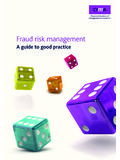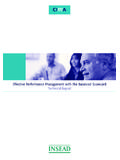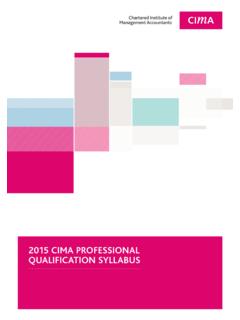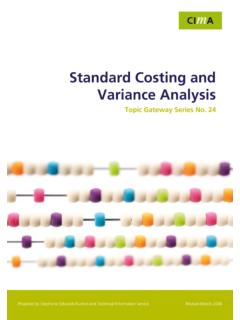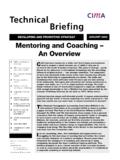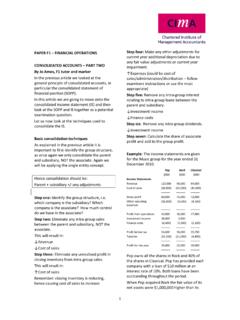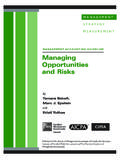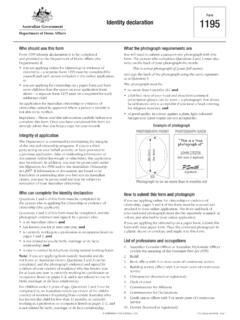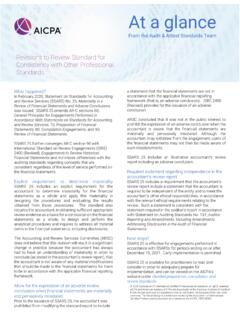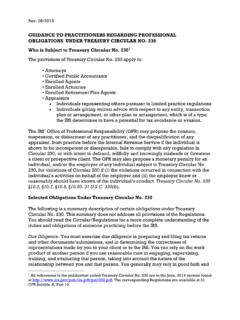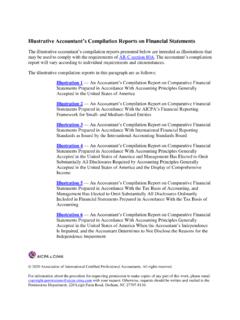Transcription of Financial Risk Management for Management Accountants
1 Management ACCOUNTING GUIDELINEBy Margaret Woodsand Kevin DowdFinancial RiskManagement forManagementAccountantsPublished by The Society of Management Accountants of Canada, theAmerican Institute of certified Public Accountants and The CharteredInstitute of Management 2008 by The Society of Management Accountants of Canada (CMA Canada), the American Institute of certified Public Accountants , Inc. (AICPA) and The Chartered Institute of Management Accountants (CIMA). All Rights part of this publication may be reproduced, stored in a retrieval system or transmitted, in any form or by any means,without the prior written consent of the publisher or a licence from The Canadian Copyright Licensing Agency (AccessCopyright).
2 For an Access Copyright Licence, visit or call toll free to 1 800 893 : 1-55302-228-9 NOTICE TO READERSThe material contained in the Management Accounting Guideline Financial Risk Management for ManagementAccountants is designed to provide illustrative information with respect to the subject matter covered. It does notestablish standards or preferred practices. This material has not been considered or acted upon by any senior or technical committees or the board of directors of either the AICPA, CIMA or CMA Canada and does not represent anofficial opinion or position of either the AICPA, CIMA or CMA ACCOUNTING GUIDELINECONTENTS PageEXECUTIVE SUMMARY ..4 INTRODUCTION.
3 4 DIFFERENT TYPES OF Financial MANAGE Financial risks ? ..7A RISK Management Identification and Assessment ..8 Risk Response ..9 Risk Control of Risk Financial risks ..10 Regression Analysis .. Analyses ..12 TOOLS AND TECHNIQUES TO MITIGATE RISK ..14 Market Risk Tools ..14 Credit Risk Tools ..18 Tools to Manage Financing, Liquidity, and Cash Flow risks ..19 Tools and Techniques to Control Risk: Summary ..20 The Need for Clear Hedging Policies and Understanding of Derivatives Trading ..25 ENDNOTES ..26 BIBLIOGRAPHY ..2734 Management ACCOUNTING GUIDELINEE xecutive SummaryThis Management Accounting Guideline (MAG) summarizesthe basic principles of Financial risk Management .
4 TheMAG first briefly outlines (a) the different types of financialrisk that firms may face, (b) the basic elements of a riskmanagement framework, and (c) the benefits of managingfinancial risks . The MAG s core sections then focus on theinterlinked issues of risk assessment (or quantification) andpossible control tools. Risk assessment and control toolsare suggested for each type of Financial risk, and real-worldexamples are used to illustrate the discussion. A casestudy of the Financial risks and the Financial risk manage-ment choices available to Pietrolunga, a fictitious specialistItalian lumber merchant, shows how the suggestedmethods may be applied in practice. A glossary of keyterms provides a quick source of reference.
5 Underlying all of the material in this MAG is the premisethat the key aim of Financial risk Management is to assistmanagement in controlling risks that may affect theachievement of organizational objectives. There is nosingle ideal risk Management package, but risks will bemanaged most effectively if sound judgment and commonsense are combined with the use of a judicious mix ofqualitative and quantitative risk Management has ranked very high on thecorporate agenda since the early 1990s, but the largelosses experienced in the last couple of years indicate that many firms are still a long way from managing theirfinancial risks effectively. IntroductionWhile some of the tools and practices described in thisMAG have been developed by risk managers for use inand by Financial institutions, the primary target audience for this MAG is the Financial manager in non-financialorganizations that face an array of Financial risks andchallenges inherent in doing business in today s Management is concerned with understanding andmanaging the risks that an organization faces in its attemptto achieve its objectives.
6 These risks will often representthreats to the organization such as the risk of heavylosses or even bankruptcy. Risk Management hastraditionally associated itself with managing the risks ofevents that would damage the organization. Organizations face many different types of risk. Theseinclude risks associated with (a) the business environment,(b) laws and regulations, (c) operational efficiency, (d) theorganization s reputation, and (e) Financial risks . These Financial risks relate to the Financial operation of a business in essence, the risk of Financial loss (and in some cases, Financial gain) and take many different forms. Theseinclude currency risks , interest rate risks , credit risks ,liquidity risks , cash flow risk, and financing risks .
7 Theimportance of these risks will vary from one organization to another. A firm that operates internationally will be moreexposed to currency risks than a firm that operates onlydomestically; a bank will typically be more exposed tocredit risks than most other firms, and so forth. It is frequently suggested that the key driver of change hasbeen a series of economically significant and large-scalefinancial disasters. To give just a few examples: in 1993,Germany s Metallgesellschaft AG lost $ billion in oilfutures trading, and in the following year the US munici-pality, Orange County, was forced to file for Chapter 9bankruptcy following massive losses from speculating onderivatives.
8 In 1995, Barings Bank in the UK failed due tounauthorized derivatives trading by an offshore in 1998 the hedge fund Long Term Capital Manage-ment (LTCM) collapsed demonstrating that having twoNobel Prize-winning finance experts on its board ofdirectors offered only limited protection from financialrisks. Then there was the fall of Enron in 2001 and theaccompanying collapse of Arthur Andersen, the majoraccounting firm that acted as Enron s external last couple of years have witnessed a considerablenumber of huge losses involving many of the world sleading Financial institutions. Indeed, recent eventssuggest that many firms including many financialinstitutions that should really have known better still havea lot to learn about effective Financial risk Management .
9 The Financial risk Management disasters of the last fifteenyears or so have (a) made it clear that risk Management is fundamental to good corporate governance, and (b) prompted a number of responses relating togovernance and internal control. Among these, theCombined Code in the UK and the King Report in SouthAfrica. All see risk Management as part of the internalcontrol process for which the board of directors isresponsible. Similarly, in the USA the Sarbanes Oxley Act (SOX) of 2002 requires companies to establish andmaintain an adequate internal control structure for Financial reporting. Over this same period, company managers have alsoincreasingly recognized the potential for effective riskmanagement to add value to an organization, and thelanguage of risk Management has started to permeate theday-to-day language of business.
10 As a result, it is nowcommonplace to consider the risk implications of manybusiness decision-making problems, such as (a) makingbudgetary choices, (b) choosing between alternativeFinancial Risk Management for Management Accountants5operating plans, and (c) considering investment reporting and risk disclosure are also becomingincreasingly important as stakeholders wish to know moreabout the risks that their organizations are , there is huge variation in the level of resourcesthat are devoted to risk Management across organizationsof differing sizes. At one end of the scale, the riskmanagement function may be performed by a single riskchampion or a part-time risk manager. At the other end ofthe scale may be found a dedicated risk managementdepartment headed by a chief risk officer with a seat on theboard.
